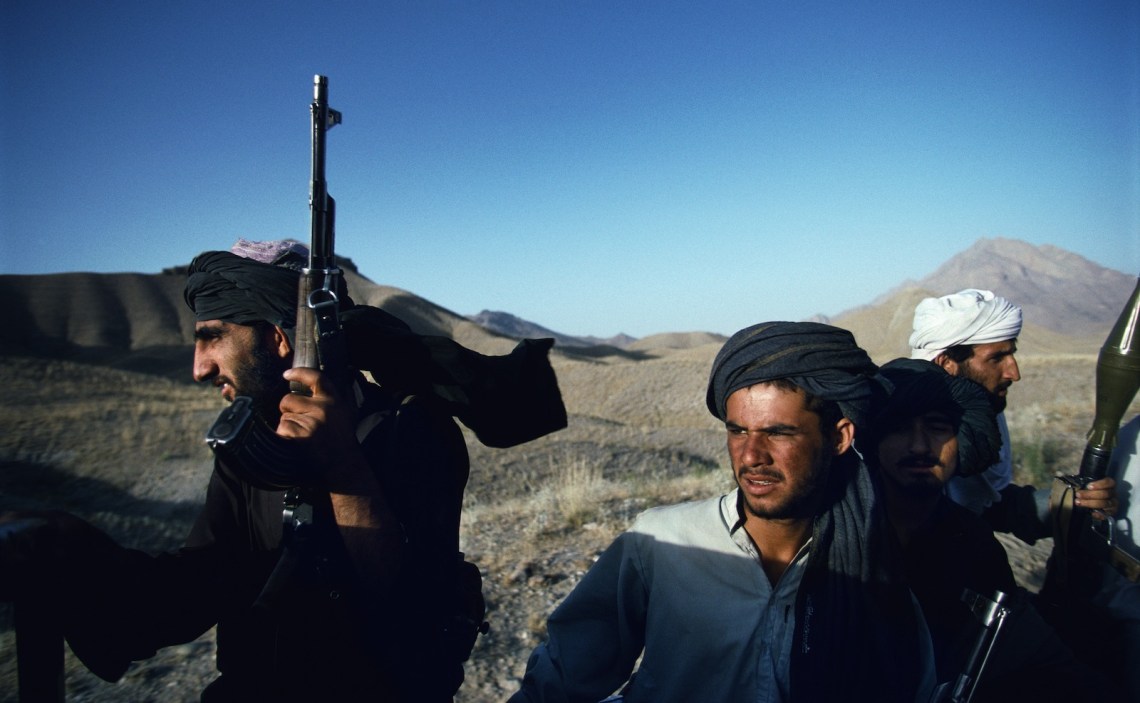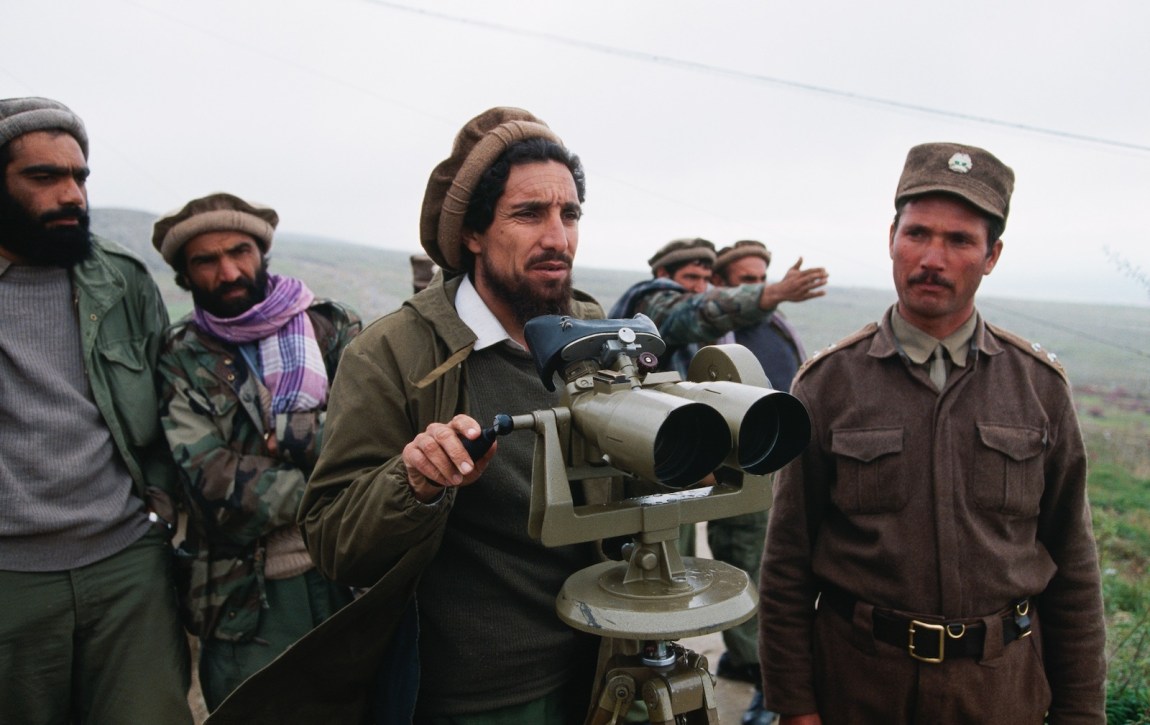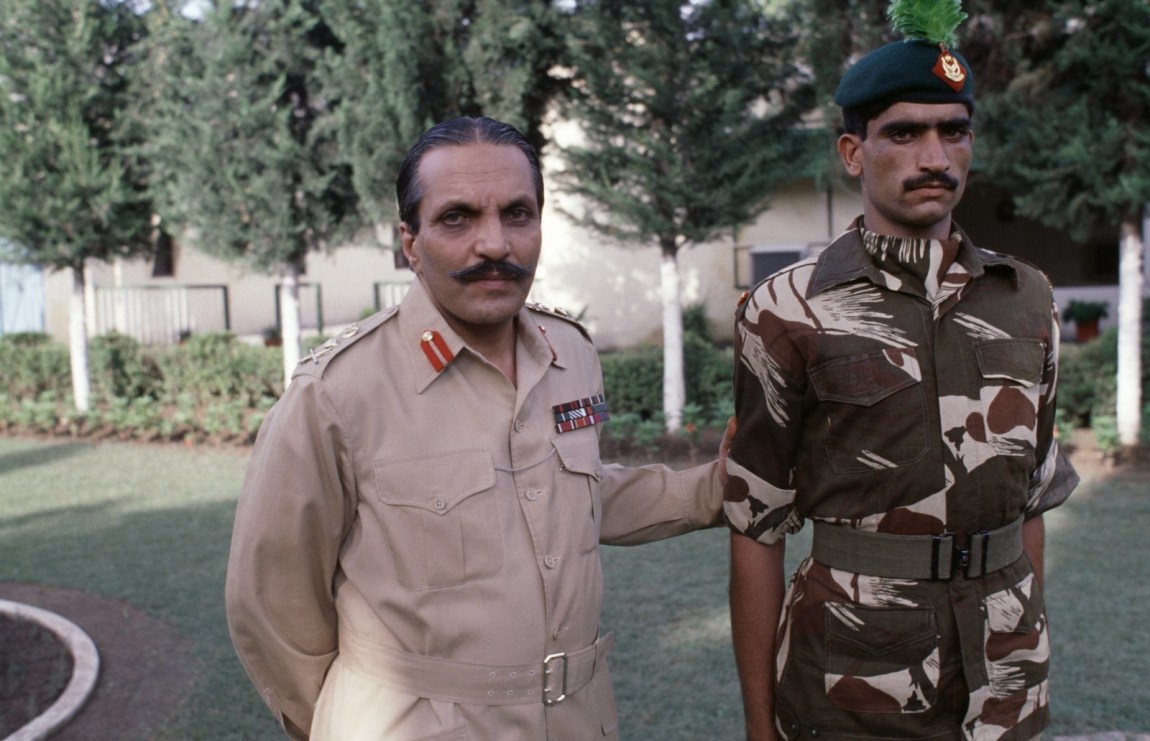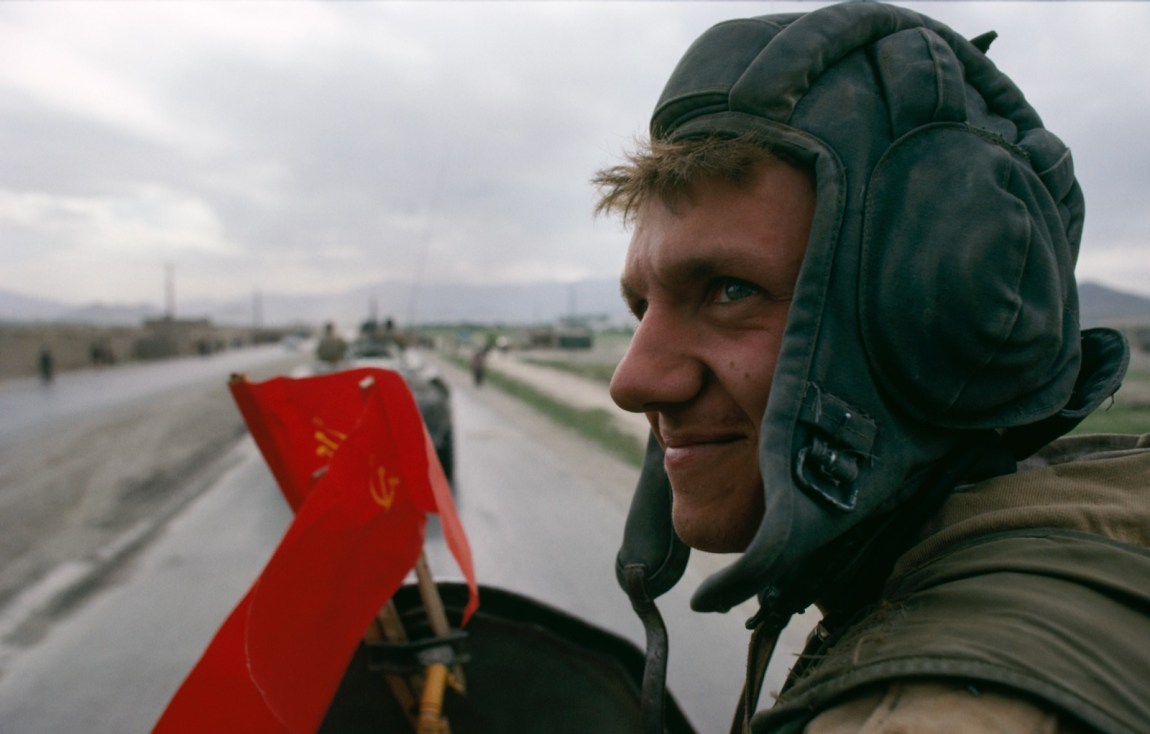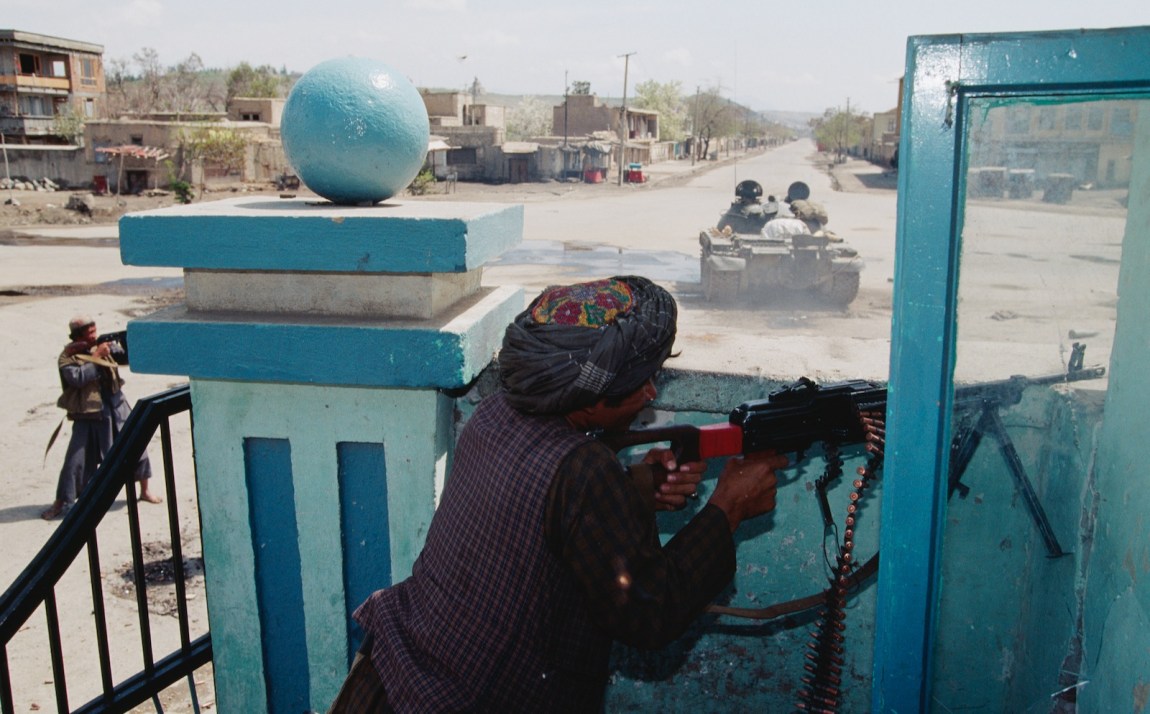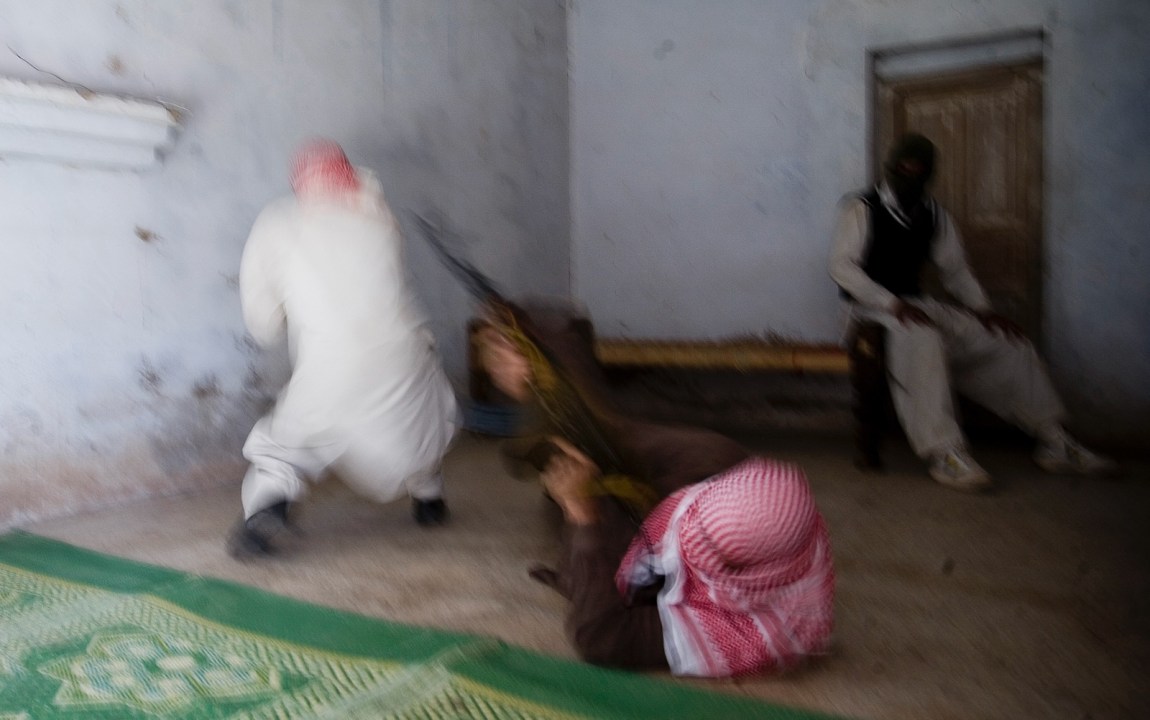A month after Soviet forces withdrew from Afghanistan, in February 1989, ending their nine-year occupation of the country, Afghan rebels, encouraged by Pakistan’s spy agency, Inter-Services Intelligence, or ISI, initiated an attack on Jalalabad that they hoped would be the prelude to a march on Kabul. The rebels’ confidence was not unfounded: this makeshift guerrilla force, trained by the ISI and armed by the West, had defeated the Soviet 40th Army, which even the German Wehrmacht hadn’t been able to vanquish. With the ISI’s blessing, Gulbuddin Hekmatyar, the hardline Pashtun leader of the Hezb-e-Islami, or Party of Islam, decided to abandon traditional hit-and-run tactics and, with 10,000 mujahideen, launched a frontal assault on Jalalabad.
The attack was a disaster. The mujahideen were poorly coordinated and ill-disciplined. They gave no quarter to surrendering soldiers, only encouraging the rest to fight harder. Regime forces hit the rebels with everything in their arsenal, including bombers and Scud missiles. By the time Hekmatyar’s forces retreated, they had lost 3,000 men. Some 12,000 civilians had also perished in the fighting. A year later, a similar assault on Kabul also ended in defeat.
Despite the ISI’s full support, Hekmatyar would never take Kabul. When the Soviet-supported regime of Muhammad Najibullah finally fell, two years later, it was to Ahmad Shah Massoud’s Tajik forces, which had received little support from the ISI. The subsequent war between rival mujahideen factions would leave the country in ruins and create space for a third force, the Taliban. The Taliban, also aided by the ISI, would go on to capture Kabul, but would then defy the agency and pave the way to their own defeat in 2001.
A myth has persisted ever since among Western journalists, diplomats, and liberal internationalists that Pakistan controls outcomes in Afghanistan and that the ISI is an omnipotent force, frustrating the best-laid plans of Afghanistan’s Western benefactors. And in the US in particular, both on the left and among the isolationist right, a separate myth endures that Jimmy Carter baited the Soviet Union into invading Afghanistan by arming extremist proxies, and that the September 11, 2001, attacks and everything that followed were the unanticipated consequences of this folly. One myth ascribes too much agency to one local actor, the other ascribes too much agency to external powers. Because of the ways they have informed and guided Western engagement with Afghanistan, these misleading narratives have done immense damage.
The truth is less dramatic and more complex. Afghanistan has suffered at many hands, but every unhappy encounter has been unhappy in its own way, and no calamity has occurred without the participation of the country’s own elites. Foreign powers have only advanced their agenda in Afghanistan when their aims have converged with those of powerful interests within the country, and their successes have been impermanent, subject to the law of unintended consequences. By ignoring the concerns of the Afghan public, they’ve generated resentment.
The ISI and the CIA have at times been able to tap the rage of disaffected Afghans, but neither agency has had the capacity to “create” an insurgency in Afghanistan. Afghan resistance to the Soviets was popular and indigenous; the West erred not in supporting it, but in squandering the goodwill its aid had bought after the Red Army’s defeat in 1989. The post-2001 Western mission in Afghanistan was undone by its expedient alliances, and its exclusion of most Afghans from its nation-building exercise, which left a large enough pool of resentment for the ISI to exploit.
For its part, Pakistan has, through its Afghan policy, staged less a power play than a desperate effort to mitigate its weakness vis-à-vis India, the rising regional superpower. And to understand Islamabad’s actions, it is necessary to revisit Afghanistan’s and Pakistan’s tangled mutual history.
*
There is no other country whose fate is more intertwined with Afghanistan’s than Pakistan’s. The two nations have deep historical and cultural ties: Ahmad Shah Durrani, the eighteenth-century founder of modern Afghanistan, was born in Multan, now part of Pakistan; and the city of Peshawar used to be the Durrani’s winter capital. Their shared 1,640-mile border has been a continual source of anxiety for the Pakistani government, which, like the British Raj before it, has sought to prevent a hostile regime from emerging in Kabul. But if for Britain this stance was part of an imperial “great game,” for Pakistan, the concerns are existential.
Born of a traumatic partition in 1947, modern Pakistan suffers from an enduring sense of vulnerability. Its founding was attended by calamities that still haunt the national psyche. For all of India’s riches, imperial Britain had failed to secure India’s northwestern frontier; Pakistan inherited all the Raj’s security challenges with a fraction of its assets. The newly independent nation’s military was formed from the rump of the old British Indian Army, and immediately after partition the country became embroiled in a conflict with its powerful southern neighbor over Kashmir, a Himalayan region with a majority Muslim population, which India had seized with British help. Pakistan’s most populous province, Bengal (“East Pakistan”), was separated from it by over a thousand miles. And Afghanistan—the only country to vote against Pakistan’s admission to the United Nations—was soon making irredentist claims on Pakistani territory. Together, Afghanistan and India were supporting Pashtun separatists along Pakistan’s northwestern border.
Advertisement
The 1947–1948 war over Kashmir underscored Pakistan’s weakness. Its military saw an urgent need to modernize, and politicians saw the need for a great-power patron. But the USSR favored New Delhi and the US had little at stake in South Asia. Later, in the mid-1950s, John Foster Dulles saw Pakistan’s potential as a strategic asset and signed the country up for two defense treaties: SEATO and the Baghdad Pact (later renamed CENTO). But the limited military assistance came at the price of major Cold War commitments, and Pakistan decided to do the minimum to justify US support while shielding its core interests from American scrutiny. Thus, while formally bound in an anticommunist alliance, Pakistan forged a close relationship with communist China, supported the US position on Korea without committing troops, and demurred on Vietnam.
Pakistan’s early security challenges had a lasting effect on the character of the state. Government revenues were diverted toward defense, creating an imbalance whereby the military gained at the expense of civilian institutions. The military tried to consolidate its position by subverting Pakistan’s nascent democracy. Its preferred instrument was its spy agency, the ISI, founded in 1948 by Walter Cawthorn, an Australian-born officer of the British Indian Army, who modeled it on Britain’s secret intelligence service, MI6. During General Ayub Khan’s military dictatorship, from 1958 to 1969, the ISI was first deployed against the country’s civilian leaders. In turn, Pakistan’s civilian leaders proved just as willing to use the ISI against their rivals. It was during Zulfiqar Ali Bhutto’s civilian government in the 1970s that the ISI established a formal office devoted to domestic espionage.
Until that point, the ISI had remained a marginal entity, still headed by a one-star general. Its record was unremarkable. It was the anti-Soviet war that would enhance its power and prestige.
*
Afghanistan’s current troubles began on July 17, 1973. After four decades of relative stability, the benign but ineffectual monarchy of King Zahir Shah ended in a coup staged by his cousin Muhammad Daoud Khan. Daoud declared a republic with the support of the People’s Democratic Party of Afghanistan (PDPA), a Leninist party founded in 1965 by Nur Muhammad Taraki, a Pashtun Marxist. He cracked down on Islamists, but as the years passed became more intransigent and autocratic, in the end also turning on his radical allies.
Following his ascent to power, Daoud had renewed claims over Pakistani territory. His government was providing sanctuary and support to secessionists along the border, with Pashtun in the north and Baluchs in the south. Pakistan’s civilian government at the time, under Bhutto, retaliated by welcoming Afghan dissidents who opposed Daoud’s communist-backed government. Among these were three Islamist activists from Kabul University who would later rise to prominence: Ahmad Shah Massoud, Gulbuddin Hekmatyar, and Burhanuddin Rabbani. On Bhutto’s instructions, his Afghan affairs adviser Naseerullah Babar arranged for five thousand Afghans to be trained by the paramilitary Frontier Constabulary. However, after Massoud’s failed attempt to lead a rebellion in 1975, Bhutto and Daoud realized that the contest was ruinous and moved toward rapprochement. This budding détente was cut short with Bhutto’s overthrow in 1977 and Daoud’s a year later, in April 1978.
Daoud and his entire family were murdered by PDPA-aligned officers. The new Afghan government, led by Taraki, initiated a process of forced modernization whose limited gains were offset by a huge increase in repression, generating resentment across the country. The new regime executed as many as 27,000 political prisoners at Kabul’s Pul-e-Charkhi prison alone.
Taraki’s tyrannical rule soon provoked resistance. In March 1979, protests in the western province of Herat turned into a full-fledged insurrection when a division of the Afghan Army dispatched to quell the rebels mutinied. Taraki sent in loyalists and struck the city with Soviet-made Il-28 bombers, killing up to five thousand inhabitants. A month later, Afghan forces perpetrated a massacre of more than a thousand civilians in Kerala, a town in Kunar. Eastern provinces were soon up in arms, and in August another army brigade joined the revolt. Seeing their Afghan allies on the ropes, the Soviets rushed in three hundred tanks and a squadron of Mi-24 Hind helicopter gunships along with thousands of military advisers. Taraki dispatched the armored Mi-24s, flown by Soviet pilots, to Kunar, where they terrorized the population for the next seven years.
Advertisement
The Soviets were reluctant to get directly involved. But in September, Taraki was overthrown by his Columbia-educated protégé, Hafizullah Amin, who denounced his predecessor and disbanded the secret police, which, Amin revealed, had killed thousands of Afghans. He even sought assistance from Pakistan. But as the rivalry among its Afghan allies turned fratricidal, the USSR finally acted. As in Hungary in 1956 and Czechoslovakia in 1968, the Soviet intention was to install a pliant regime and withdraw. In the first dramatic act of the invasion, a unit of Spetsnaz special forces assassinated Amin, replacing him with Babrak Karmal from the PDPA’s less radical, Tajik-led “Parcham” wing.
For its part, the Carter administration had also been reluctant to intervene. In July of 1979, the US government had approved $695,000 for propaganda operations and nonlethal aid for the anti-PDPA rebels. But with the Soviet invasion, the White House’s calculations changed. Under fire for his perceived weakness over Iran, and urged on by national security adviser Zbigniew Brzezinski, President Carter dispatched a clandestine shipment of World War I-era, bolt-action Lee-Enfield .303 rifles, which arrived in Afghanistan ten days after the invasion.
The small arms left the rebels scarcely less disadvantaged against the Soviets’ modern military. In March 1980, in its first major operations, an armored division of the Red Army entered Kunar and responded to sniper fire by destroying entire villages. In May, it killed 1,800 civilians in the valley bordering Pakistan. It responded to an ambush a month later by blowing up a mujahideen base. And so it went. PDPA repression had forced 400,000 Afghans to flee to Pakistan. After the Soviet invasion, that number would swell to nearly five million.
The weight of circumstances would soon force the US and Pakistan to set aside misgivings and forge an alliance that would prove fateful for Afghanistan.
*
The Soviet invasion had caused alarm in Washington and Islamabad. So, after years of diplomatic chill, the two states found their interests converging. But mutual distrust remained. Pakistani president General Zia ul-Haq rejected the US’s initial offer of $400 million to bolster anti-Soviet resistance, calling this aid “peanuts.” For the first two years of the Soviet occupation, support to the mujahideen remained nominal and the poorly armed Afghans suffered heavy losses. But in 1982, then CIA director Bill Casey engineered a military aid program through which the Saudis would match US funds. The arrangement also made the ISI the principal channel for external aid to Afghan rebels.
Despite occasional successes, however, the balance of power remained unchanged. Flying in packs, Soviet Mi-24s inflicted heavy casualties on rebels and civilians alike. Afghans could ambush tanks and infantry but remained helpless against the Hinds. Yet both the ISI and the CIA were reluctant to provide anti-aircraft missiles to the rebels lest they fall into hostile hands or be used against civilian aircraft. Zia was wary, since in early 1982, his own official C-130 had narrowly escaped a SAM-7 missile attack by Al-Zulfikar, a terrorist group formed by the sons of the deposed Bhutto, which received training and support from the Indian and Afghan intelligence services. But with the increasing violation of Pakistani airspace by Soviet jets and heavy fighting along the border in April 1986, minds changed.
On September 25, 1986, in the first deployment of the Stinger missile, ISI-trained mujahideen brought down three Mi-24s in Jalalabad. In the following year, Stingers destroyed 270 Soviet aircraft, forcing the Red Army to radically change its tactics. Soviet bombers could now only fly at high altitude and, denied the air cover, Soviet ground forcesceased most offensive operations by 1987. A year later, the Soviet premier Mikhail Gorbachev signed the Geneva Accords, announcing the withdrawal of all troops. By the time the Soviet military retreated in February 1989, it had left behind 15,051 soldiers dead or missing, over a million dead Afghans, and at least a quarter million landmines: a country in ruins.
The war had left most Afghans weary, but mujahideen commanders and their Pakistani patrons were jubilant. Their hubris would prove deadly. Kabul, which had been mostly spared by the war, bore the brunt. First, there was a deadly siege; later, after its fall to Massoud, a reign of terror imposed by Massoud’s ally, General Dostum, and indiscriminate rocket barrages by his rival, Hekmatyar. The capital was reduced to rubble, leaving in the dust, among other things, the reputation of the once-heroic mujahideen. By then, the rebels had devolved into a collection of private armies controlled by power-hungry warlords willing to sacrifice any number of lives in their game of thrones.
The ISI, which had shown tactical brilliance against the Soviets, would soon reveal the limits of its strategic vision. During the war, the ISI’s allies had fought well in Afghanistan; yet it was Massoud’s Tajiks that achieved the more dramatic victories. Likewise, during the Soviet occupation, the ISI had succeeded in bringing disparate Afghan factions under more coherent command to defeat the Soviets, but later, in its aim of installing a friendly government in Kabul, it was thwarted by their irreconcilable interests.
There were other setbacks, too. Before the Soviet withdrawal, the ISI’s arsenal at the Ojhri Camp near Rawalpindi was destroyed in a spectacular act of sabotage. Shortly after the Red Army’s departure, the ISI chief Akhtar Abdur Rahman was assassinated, along with General Zia, in a plane crash. The limits of the ISI’s influence were also revealed when, in defiance of Pakistani advice, Hekmatyar sided with Saddam Hussein against the US during the 1990–1991 Gulf War. Despite full ISI support, Hekmatyar was still flailing four years after the Soviet retreat. By 1994, Afghanistan was in chaos, with rival warlords carving out their own fiefdoms while grinding down the civilian population. But a development unforeseen by the ISI would soon change its fortunes.
*
For most mujahideen, the war had ended when the Russians left. Among these was Mullah Omar, a prayer leader from Kandahar who had lost an eye in combat. Witnessing the criminality that accompanied the civil war that followed the Soviet withdrawal, however, Omar and his comrades decided to act. The trigger was reportedly the abduction and rape of two young women by a local warlord. Omar responded to the family’s call, and, with his fellow fighters, rescued the women and executed the warlord. The act quickly became legend, and in a place without functioning authority or recourse to justice people started bringing their grievances to Omar. The new movement’s ranks comprised young seminarians known as “talibs,” most of them orphans of the Afghan war who had studied in Pakistan.
One person monitoring these developments was Naseerullah Babar, now the interior minister in Benazir Bhutto’s administration. Pakistan’s government had been trying to open a trade corridor with Central Asia, a matter that acquired urgency after the country’s cotton crop failed in 1994. According to Hein Kiessling’s history of the ISI Faith, Unity, Discipline (2016), Bhutto’s husband, Asif Ali Zardari, bought much of Turkmenistan’s cotton harvest that year, but Babar failed to negotiate transit for it through northern Afghanistan. So he tried a new tack and sent a convoy of trucks through southern Afghanistan, where it was predictably seized by a local warlord. Babar appealed to Mullah Omar for help, and Omar’s men captured the warlord and released the trucks. In return, Babar allowed Omar’s men to seize an ISI weapons cache that had been meant for Hekmatyar.
The movement soon captured Kandahar and gained unstoppable momentum. It was only then that the ISI took notice and, after abandoning Hekmatyar, threw its weight behind the Taliban instead. Omar’s forces also received support from trucking magnates in Pakistan, which could now send convoys safely through Taliban-controlled territory with a single toll instead of being extorted by every warlord along the route. By 1996, the Taliban had seized Kabul and much of Afghanistan, and Pakistan had become their sole diplomatic channel to the world.
The Taliban, however, had no vision of governing beyond imposing its harsh social conservatism on the citizenry. The regime’s oppression was unrelieved by economic opportunity or personal security for ordinary Afghans, and none suffered more than women and minorities. The country’s new rulers also sowed the seeds of future grief—and their own destruction—by allowing Osama bin Laden to settle in Afghanistan.
The relationship between the Taliban and al-Qaeda was complicated: one was an Islamist movement with territorial ambitions, the other a transnational jihadist movement whose leaders believed that despotic rule in the Muslim world was impossible to dislodge without first defeating its distant enabler, the US. The Taliban were happy to use al-Qaeda volunteers as shock troops in their war against the rival Northern Alliance (the Tajik-led coalition whose rule the Taliban had ended), but were wary of any unauthorized actions that could blow back on their interests. In the years after al-Qaeda’s 1998 embassy bombings in Kenya and Tanzania, the Taliban tried to restrict Bin Laden’s access to the media.
Bin Laden’s presence in Afghanistan put Pakistan in a quandary. As one of only three governments to formally recognize the Taliban regime, Pakistan was under pressure to use its sway to deliver Bin Laden to the US. But attempts by three successive ISI chiefs to get the Taliban to banish him were rebuffed. Instead, the Taliban activated their supporters among Pakistani Islamists—particularly the Jamiat Ulema-e-Islam, which ran the madrassa networks from which the talibs had emerged—to undermine any attempts to pressure them. By 2001, Mullah Omar felt bold enough to write a letter to Pakistan’s president, Pervez Musharraf, demanding that his country, too, adopt Islamic rule.
But the Taliban’s repression and misrule had thoroughly alienated Afghans who had initially seen them as a relief from the country’s chronic instability. Few mourned when the regime was toppled in 2001. The Taliban, skeptical of the charges against Bin Laden and reluctant to violate Pashtun tradition, had refused to extradite him, and were incredulous that the US would attack them for a crime that had involved no Afghan. Pakistan, however, understood the danger, and dispatched the ISI chief to Kandahar to advise Mullah Omar against jeopardizing Taliban rule by protecting Bin Laden. Omar rejected the advice.
Kabul fell two months later. There were scenes of jubilation: men shaved off their beards, girls returned to school, music played in the streets, and women left their homes unchaperoned. Mullah Omar went into hiding and his forces melted away. Hamid Karzai was appointed interim president and most Taliban rank and file acceded to his rule. Afghanistan was at the center of the world’s attention, engendering hope that it could finally escape its long ordeal.
But instead of setting it on a path to progress, the US delivered Afghanistan to its past. In its haste to defeat the Taliban, the US forged expedient alliances that sabotaged future efforts to form a credible and representative government. The occupation empowered the very forces whose depredations had made the Taliban seem, for a time, an improvement. There were revenge killings by America’s new allies, some taking grisly form. General Dostum, the Uzbek warlord, had his men put surrendered Taliban fighters into shipping containers and drive them across a scorching desert, executing those that survived. While the telegenic Karzai headed the new state, real power remained with the warlords. US diplomats recognized that their abuses and corruption made the new regime dysfunctional, but the CIA and the Pentagon continued to cultivate these relationships in pursuit of their “war on terror.” The US spy agency even reconstituted the communist-era Afghan intelligence service, KhAD, rebranded as the National Directorate of Security (NDS).
The US made the mistake, one it would repeat in Iraq, of excluding the vanquished from any place in the country’s new administration. Taliban leaders who agreed to lay down their arms and reconcile with the new government were arrested and bundled off to Guantánamo. Denied the option to renounce arms or participate in the new order, the surviving Taliban laid low. For a time, even Pakistan was inhospitable, handing many of their leaders over to the US.
With the Taliban no longer a threat, Washington’s new allies turned on one another. To maximize their power and influence, the warlords harnessed American firepower against their rivals. This reaped them dual rewards: by denouncing an opponent as Taliban, they could get Americans to eliminate him while also earning kudos for their service to the war on terror. For Afghans in the countryside, their main experience of the Western presence came in the form of special forces night raids and drone strikes. Over the course of the war, the US launched more than 13,000 such strikes; according to UN data, airstrikes resulted in 2,122 civilian deaths, including of 785 children, between 2016 and 2020 alone.
The US victory also marked the return of the opium trade, which the puritanical Taliban had banned before its fall. During the occupation, despite haphazard eradication efforts, the opium trade flourished, and both US allies and the Taliban were able to profit from it. For the US-aligned warlords, the eradication program served as an opportunity to eliminate rivals and secure their own monopolies. Poppy cultivation increased, totaling more than half a million acres by 2021—a 37 percent jump just over the past year.
*
After September 11, 2001, the US again turned to Pakistan for help; and though Islamabad formally joined the US war on terror, its commitment was less than wholehearted. Pakistan felt used and abandoned after the anti-Soviet war, and the US had added insult to injury by imposing punitive sanctions on Pakistan, even scaling down cultural and educational programs. Then president Pervez Musharraf accepted US support but without ceding any more help than he deemed necessary. For Pakistani leaders, the logic is simple: Pakistan has never been more than an inessential ally, and America’s episodic support has been limited to its own geopolitical interests. The US has never backed Pakistan on its overriding foreign policy concern, Kashmir. At times, it has even aided Pakistan’s chief rival, without regard to the regional balance of power.
In the 1980s, Pakistan had supported Afghans at the risk of direct confrontation with the Soviet Union and sheltered five million refugees, while India tacitly supported the invasion. After the war, there was a scramble among regional powers for influence in Afghanistan, and India gained a foothold through its support for the Northern Alliance. So, when the US helped put the India-friendly Northern Alliance into power, it rankled Pakistan.
To curb Indian influence, preventing Northern Alliance rule became a strategic imperative for Pakistan, despite the formal alliance with the US. With the US preoccupied with Iraq in 2003, Pakistan restored its support for the Taliban. Western remonstrations over the Taliban’s unsavoriness were met with disdain in Pakistan since the US was now in league with the likes of Dostum. Pakistan’s leaders knew that the US would eventually disengage, as it had after the Soviet withdrawal, and saddle them with the consequences. By 2003, Pakistan was already destabilized by spillover from the war on terror, which in 2007 would explode into a full-blown insurgency.
Local anger at the CIA’s frequently indiscriminate drone strikes was exploited by militant groups to form the Tehreek-e-Taliban Pakistan (TTP), a radical and unabashedly sectarian force that was soon launching terrorist attacks across Pakistan, killing over 23,000 civilians. In the fight against the TTP, Pakistan would lose around 8,000 soldiers. Following several Pakistani Army operations, the TTP eventually fled to Afghanistan’s eastern provinces, where in 2014, its members founded the Islamic State–Khorasan Province (ISKP), a regional franchise of the Islamic State. The ISKP initially received support from the National Directorate of Security as a potential proxy against the Taliban and Pakistan, but the group was too volatile and turned on its Afghan benefactors. It remains a threat to both Afghanistan and Pakistan (it also claimed responsibility for the deadly attack on Kabul airport during the US withdrawal last August).
Ironically, this has for the first time created a convergence of interests between the US, the Taliban, and Pakistan. All seek the elimination of the ISKP. The US has proclaimed its intention to keep an “over-the-horizon” capacity to strike the ISKP. But the early prospects do not look good. The US war on terror in Afghanistan ended much as it started—with a drone strike that misidentified its target and killed civilians.
Pakistan and the US have pursued different goals but followed a common approach: they’ve seen Afghanistan primarily through a security lens. This has engendered little trust among Afghans. Under Western occupation, there were tangible gains in the areas of education and health care, but most felt excluded from the benefits, and many of the billions of dollars in foreign aid were siphoned off by the country’s new elite. In addition, the disregard for civilian life in the war on terror created resentments that the Taliban were able to exploit. As a final insult, in deciding which Afghans to evacuate the US gave priority to those who had assisted the military occupation, including the NDS’s Zero Units, which were implicated in many extrajudicial killings. Contrary to conventional wisdom, the US never really engaged in “nation-building”; instead, it made a clumsy attempt at political engineering, one that put counterterrorism objectives before the interests of Afghans.
Pakistan has borne the principal refugee burden, sheltering more Afghans than any other country over the past four decades. But because of Islamabad’s ruthless pursuit of influence, it is regarded with suspicion even by supposed allies. While the Taliban benefited from Pakistani support, they have not forgotten the ISI’s capture and extradition of their leaders to Guantánamo. The ISI itself imprisoned Mullah Abdul Ghani Baradar, who is now Afghanistan’s deputy prime minister; and the former Taliban defense minister, Obaidullah Akhund, died in ISI custody, reportedly of heart disease but his comrades suspected torture. The same fate was nearly shared by the the group’s former finance minister, Gul Agha Ishaqzai, who was beaten nearly to death death in ISI custody. “Pakistani prisons are worse [for the Taliban] than Bagram or Pul-e-Charkhi,” Afghanistan’s foreign minister under the Taliban’s earlier regime, Wakil Ahmad Muttawakil, has said.
Even with their partial victory in the 1990s, the Taliban defied Islamabad. And with their comprehensive triumph in 2021, they are unlikely to be subservient. There have already been border clashes between the Taliban and Pakistani troops. Given the two countries’ mutual needs, the sporadic violence will likely resolve into an entente, but it will not be the client-patron relationship that most commentators perceive it to be.
Since its inception, Pakistan’s Afghan policy has been a surrogate for its Kashmir policy. In failing to understand this, the US guaranteed that Afghanistan’s closest neighbor would have no stake in the success of the American mission. With the Taliban’s return to power, Pakistan has finally seen Indian influence banished from Afghanistan, but in defusing this latent threat, Islamabad has created more active challenges.
For the past two decades, Afghanistan was sustained by foreign aid; it is now facing famine. In a myopic attempt to punish the Taliban, the US has decided to freeze Afghan assets, leaving the country on the brink of starvation and engendering new resentments. For now, Pakistan is rallying Muslim states to provide humanitarian relief. But even if the current crisis is averted, Afghanistan’s problems are unlikely to go away. The country’s new rulers have no vision for its betterment; its interim leader, Muhammad Hassan Akhund, has called the famine “a test from God,” which can be solved by prayer. Uncertain of divine intervention, 1.4 million Afghans have again taken refuge in Pakistan, a number that is likely to rise.
Pakistan wanted to keep Afghanistan pliant in its pursuit of “strategic depth.” It will now have to balance its equivocal geopolitical gains on its western flank with its responsibility to serve as a humanitarian cushion for dispossessed Afghans, even as it surveys its eroded position in Kashmir on its eastern flank.


